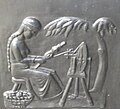Top Qs
Timeline
Chat
Perspective
Vernon Hill (sculptor)
British sculptor (1887–1972) From Wikipedia, the free encyclopedia
Remove ads
Vernon Hill (1887–1972), born in Halifax, Yorkshire, England, was a sculptor, lithographer, illustrator and draughtsman.[1][dead link]
He began his work in print-making and lithography, and branched out into other artistic forms, such as sculpture. He illustrated several works and created etchings. His more notable works were commissions from Sir Edward Maufe for interior and exterior architectural sculptures on Maufe's buildings, including Guildford Cathedral, the Runnymede Memorial and several churches.
Remove ads
Early life
Summarize
Perspective
Vernon Hill was born in 1887 in Halifax, Yorkshire. He began formal training in print-making at an early age; at the age 13 he was apprenticed to a lithographer. In about 1908, at the age of 21, Hill moved to London and took up poster illustration, working under John Hassall, a poster designer and illustrator.[1][4]
From 1909 to 1914 Hill received commissions for work as an illustrator on various projects. He created Art Nouveau illustrations for an Arcadian Calendar for 1910 in 1909, Stephen Phillips' The New Inferno in 1911 and for Richard Pearse Chope's Ballads Weird and Wonderful the following year. In 1912 one of his works was exhibited at the Royal Academy.[1][dead link][4] His etchings were described by Campbell Fine Art as follows:
The distinctive allegorical etchings of Vernon Hill are all now scarce. His highly evocative work appears to have evolved entirely independently from the trends of his time, although overtones of the mysticism which so influenced Frederick Carter and Austin Osman Spare can be traced in some of his works.[4]
Richard Pearse Chope commissioned Hill to create a series of designs for Roof Bosses at St. Nectan church, Stoke, Hartland c.1912. The bosses are in three sets; two sets are of plants and trees of which the first letter of each spell out the names of Chope's brothers (Dennis & Abbot Chope). The third set are of biblical associations. Hill is thought to have sculpted these bosses although some indicate they were done by Messers Reads of Exeter.[5]
Remove ads
Notable commissions
Summarize
Perspective
His most notable work as a sculptor is to be seen on various buildings by Sir Edward Maufe, who regularly commissioned Hill.
Guildford Cathedral
Some of Hill's finest work can be seen at Guildford Cathedral in Guildford, Surrey. Apart from the reliefs on the south door entrance he carved the angels on the sedilia inside the cathedral, as well as the tongues of flame on the pulpit and lectern. He also carved the arms of Bishop Greig over the inside of the sacristy door and the figure of Saint Ursula over the inside of St Ursula's Porch.[6][7]
At the east door of the south porch (on either side of the central buttress pier in the south transept) are two magnificent bronze doors set under two arches which feature Vernon Hill's reliefs.[8][9] These are depictions of various occupations, of both men and women. The men's occupations are on the right-hand door and include sowing, woodcutting, fishing, hunting, shepherding and ploughing; on the left-hand door are depicted women's traditional occupations including milking, spinning, and teaching.[6][7]
- Teaching
- Milking
- Spinning
- Sowing
- Shepherding
- Ploughing
Runnymede Memorial

Hill sculpted the Air Forces Memorial at Runnymede, designed by Maufe.[10] Overlooking the Thames Valley, the memorial commemorates the more than 20,000 Royal Air Force servicemen and -women who died during World War II and have no known graves. The panels of inscriptions bear their names.[11]
Among Hill's works are the architectural sculptures of Courage, Victory and Justice, which adorn the entry to the shrine on the north side of the triple arched portico by the cloisters.[12]
St Columba's Church, London

Maufe was the architect for the re-building of St Columba's Church, Pont Street, London, which had been destroyed in 1941 during World War II. Hill provided interior and exterior stone sculptures for the construction between 1950 and 1955. Maufe described the finished work as "of an especial beauty."[13]
St John's College, Cambridge
Also commissioned by Maufe, Hill completed an architectural sculpture of the arms of St John's College, Cambridge, for the north side of North Court.[14]
Church of St Thomas the Apostle, Hanwell
Hill sculpted several works out of Weldon stone for Maufe's church of St Thomas the Apostle, Hanwell. These included a sculpture of doves over the north door and one of two birds eating a bunch of grapes, depicting the Communion, over the west door. He also carved a Virgin and Child and a font. The font includes symbols for Christ, such as the ΙΧΘΥΣ cypher and an image of a fish. He also made a sculpture of Saint Christopher.[15][16][17][18]
- Hill's keystone carving of a dove over the north door
- Virgin and Child, carved in Caen stone, in the Morning Chapel (Lady Chapel)
Remove ads
Works
Remove ads
Exhibitions
Hill exhibited:[1]
- 1927 - Multiple works at Leicester Galleries: Sculpture, Drawings and Etchings by Vernon Hill
- 1928 - Multiple works at Leeds City Art Gallery, Yorkshire Artists' Exhibition
- 1930 - The Awakening at Leeds City Art Gallery, Yorkshire Artists' Exhibition
Notes
- Wolseley Fine Arts exhibition catalogue also gives 1972 as his date of death.[2][dead link] According to Christie's, however, he died in 1953.[3]
- Hill's artistic talents were described by Chope in the Foreword to Ballads Weird and Wonderful as follows: "[he] is an artist who is not limited to the actual things of life, whose fancy is not confined within the limits of a green field or a marble column - who, indeed, can see visions - whose inner life is not of our life but of a strange occult devising, is impelled irresistibly towards the supernatural."
Remove ads
References
External links
Wikiwand - on
Seamless Wikipedia browsing. On steroids.
Remove ads









